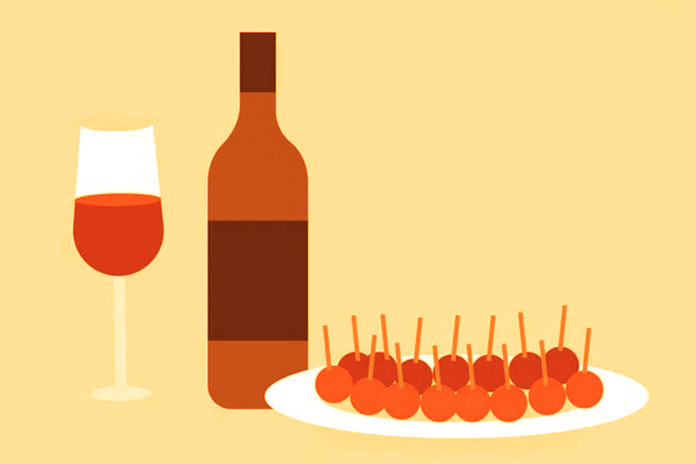What Is An Aperitif?
The etymology of the term “aperitif” comes from the Latin aperitivos, which means “that which opens.” The rule wants it to be eaten before the real meal, usually dinner, precisely because it has the function of “opening the stomach,” stimulating the appetite. A common aperitif is made up of the following:
- Cocktails (e.g., spritz, gin and tonic, mojito, bloody mary, etc.) or alcoholic beverages (wine, beer);
- Savory snacks, such as chips, pretzels, olives, pizzas or generally industrial focaccia, sandwiches filled with elaborate sauces, such as mayonnaise, ketchup, tuna sauce, etc., fried foods such as arancini or potato croquettes, fatty cold cuts, etc.
It follows that, in many cases, the caloric intake of an appetizer with appetizers can far exceed that of dinner and become a high-calorie meal, with calories derived from alcohol, fats (even hydrogenated ones ), and sugars, therefore not very nutritious.
Therefore, remember that the aperitif is a moment of leisure and socializing. Still, it can become an enemy of a balanced diet if consumed incorrectly. Introducing a higher caloric intake than a full lunch or dinner, especially if done out of habit, can make us lose control of calories and unbalance the supply of nutrients necessary for our body.
Aperitif Drinks
Alcohol is a concentrate of calories: 1 gram corresponds to about 7.3 kcal, much more than proteins and carbohydrates, which instead provide 4 kcal per gram. Furthermore, unlike all the other macro and micronutrients, alcohol contains only empty calories, i.e., energy which does not bring any nutritional substance to our body.
Furthermore, in aperitifs, sugar is also contained in tonic water, cola, etc. It is easy to understand that if a rich aperitif precedes an equally abundant meal every day, the risk of obesity is high, even if only considering the drink. Let’s see how many calories (kcal) the most popular alcoholic beverages have on average at happy hours:
- Spritz 90-100 kcal
- Gin and tonic 120-150 kcal
- Mojitos 200-250 kcal
- Negroni 180-200 kcal
- Bloody Marys 130-150 kcal
- Wine 125ml 110 kcal
- Beer 33ml 110 kcal
So, What To Drink As An Aperitif?
Advice
- Limit alcoholic aperitifs to 1-2 times a week, being careful not to overdo the appetizers.
- Avoid bitters and cocktails due to the high content of alcohol and added sugars (often flavored syrups), but also drinks that contain sugary carbonated drinks (tonic water, cola, lemonade, etc.) or sugary fruit juices. If you want to drink something alcoholic, opt instead for a small beer or a glass of wine, prosecco, or a spritz, but avoid an encore!
- Choose soft drinks, such as a fresh fruit or vegetable extract, tomato juice, citrus juice, or water flavored with fruit chunks or lime, ginger, cucumber, or mint.
What To Eat As An Aperitif
There are so many aperitif appetizers, and making a healthy choice is not always easy. Follow these tips to get your bearings.
Snacks To Limit
- Ready-made pasta or rice salads;
- french fries, pretzels, popcorn, etc.;
- stuffed olives, arancini, croquettes, and other pre-fried foods;
- industrial pizzas and focaccias;
- fatty cold cuts such as salami, coppa, mortadella, ciccioli, etc;
- canapés or sandwiches with mayonnaise or other elaborate sauces;
- Roasted and salted peanuts and pistachios.
Ideal Appetizers
- Vegetables in crudités (carrots, fennel, radishes, cherry tomatoes, celery, etc.) or pinzimonio with extra virgin olive oil, balsamic vinegar, and a little salt ;
- Grilled or baked vegetables, always without exaggerating the condiments;
- Preferably natural green or black olives;
- Wholemeal bread bruschetta with cherry tomatoes, basil, and a drizzle of extra virgin olive oil;
- A few small flakes of Grana Padano DOP, which is the cheese richest in calcium among those most commonly consumed in Italy, also contains excellent proteins with a high biological value (with nine essential amino acids), important vitamins for health such as B2 and B12 and antioxidants against free radicals such as vitamin A, zinc and selenium ;
- Egg and vegetable omelets or flans cooked in the oven;
- legume hummus ;
- Wholemeal bread sticks or dried legume chips (not fried), preferably unsalted ;
- Toasted, unsalted walnuts, almonds, or pistachios ;
- Fruit skewers.
What To Do If You Exaggerate With The Aperitif?
If during the aperitif you exaggerated with the salty snacks, or you had an encore (or trio!) of alcohol, try to lighten up the following meal by consuming foods with little fat and sugar, adding a good amount of fiber, such as vegetables to be seasoned with grated Grana Padano DOP instead of salt or a large salad. Remember that regular physical activity helps you metabolize the excess calories from the aperitif, but with a brisk 30-minute walk, you will only consume around 100 kcal.
Who Should Limit Appetizers?
People who are overweight or obese must pay greater attention to the quality and quantity of food eaten during the aperitif, especially if complicated by hypercholesterolemia or type 2 diabetes. Furthermore, we remind you that, if taken chronically in large quantities, alcohol compromises the liver’s health. Therefore, it is better to take it rarely if you already have liver conditions such as steatosis or high transaminases.


